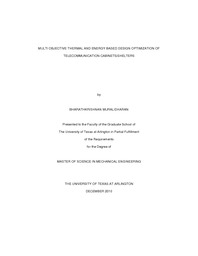
ATTENTION: The works hosted here are being migrated to a new repository that will consolidate resources, improve discoverability, and better show UTA's research impact on the global community. We will update authors as the migration progresses. Please see MavMatrix for more information.
Show simple item record
| dc.contributor.author | Muralidharan, Bharathkrishnan | en_US |
| dc.date.accessioned | 2011-03-03T21:50:54Z | |
| dc.date.available | 2011-03-03T21:50:54Z | |
| dc.date.issued | 2011-03-03 | |
| dc.date.submitted | January 2010 | en_US |
| dc.identifier.other | DISS-10875 | en_US |
| dc.identifier.uri | http://hdl.handle.net/10106/5382 | |
| dc.description.abstract | The miniaturization and convergence of the consumer electronic products such as cell phones and digital cameras has necessitated an increase in the number of transistors on a die, board and systems. This has resulted in a requirement for a more robust thermal management of such electronics to increase the reliability of the system. Access networks provide the last mile of connectivity for the telecommunication network users. In the access network, the outside plant telecommunication cabinets houses electronic components and switching devices. These cabinets are standalone outdoor enclosures, and many a times they are located in hostile environments. With the current development in the telecommunication industry migrating from 2G to 3G and later to 4G, the heat loads in the electronic equipments has increased drastically and is expected to rise further in years to come. The cooling systems typically consume 30% of the energy required to operate a wireless cell site. There is, therefore, an impetus to embark on initiatives to reduce this percentage as part of an effort to both save money, and to reduce the carbon footprint. This study purely focuses on the air cooling system deployed for cooling outdoor shelters/cabinets. A thermal optimization of the cooling system is performed and then analyzed for its energy consumption. Hence, the study is divided into parts: design guidelines for double walled telecom cabinets and thermal management of outdoor shelters using hybrid cooling system.The first part of this deals with the design and thermal analysis of an outdoor double walled telecommunication cabinet with natural and forced convection in the air gap. Commercial CFD code has been used to design and compare various double walled cabinet configurations. Design guidelines for a double walled telecommunication cabinet have been proposed taking into consideration the thermal performance and the energy consumption of the cooling system. The second part includes various thermal design options to cut down on the cooling energy loads for telecom shelters. The shelter houses a number of cabinets which have to be maintained within permissible temperature limits. The thermal impact of substituting an active cooling system with a hybrid one is analyzed. The hybrid cooling system consists of both the air conditioner and a blower. Various design options (different blower configuration) are considered for selection of the hybrid cooling system. CFD analysis is performed to compare these designs and come up with a robust design solution. The best cooling methodology showed an energy saving of 40% with negligible impact on the temperature. | en_US |
| dc.description.sponsorship | Agonafer, Dereje | en_US |
| dc.language.iso | en | en_US |
| dc.publisher | Mechanical Engineering | en_US |
| dc.title | Multi Objective Thermal And Energy Based Design Optimization Of Telecommunication Cabinets/shelters | en_US |
| dc.type | M.Engr. | en_US |
| dc.contributor.committeeChair | Agonafer, Dereje | en_US |
| dc.degree.department | Mechanical Engineering | en_US |
| dc.degree.discipline | Mechanical Engineering | en_US |
| dc.degree.grantor | University of Texas at Arlington | en_US |
| dc.degree.level | masters | en_US |
| dc.degree.name | M.Engr. | en_US |
Files in this item
- Name:
- Muralidharan_uta_2502M_10875.pdf
- Size:
- 2.169Mb
- Format:
- PDF
This item appears in the following Collection(s)
Show simple item record


